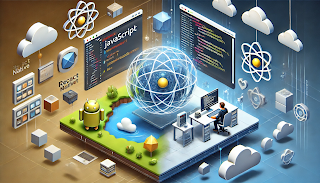The React Native Bridge:
A Core Concept
The
React Native bridge is the linchpin that enables seamless communication between
the JavaScript runtime and the native platform. It acts as a messenger,
translating JavaScript components and their updates into native
platform-specific views and vice versa.
The Code Conversion
Process
1.
JavaScript Rendering:
When a React Native component is rendered, the JavaScript engine (either
JavaScriptCore on iOS or V8 on Android) parses and executes the component's
definition.
2.
Shadow Tree Creation:
The JavaScript engine creates a virtual representation of the component's UI
hierarchy, known as the shadow tree.
3.
Diffing: React
Native efficiently compares the current shadow tree with a previous version to
identify changes. This diffing algorithm minimizes the number of updates
required.
4.
Bridge Communication:
The identified changes are sent to the native platform via the bridge.
5.
Native View Updates:
The native platform receives the updates and translates them into corresponding
native views (e.g., UIViews on iOS, Views on Android).
6.
UI Rendering: The
native platform renders the updated views on the screen.
Debugging React
Native Applications
Debugging
React Native apps can be challenging due to the hybrid nature of the framework.
Here are some effective techniques:
●
React Native Debugger:
This standalone tool provides a powerful interface for inspecting your app's
state, props, and performance. It also allows you to set breakpoints and step
through your code.
●
Console Logging:
Use console.log statements to print values and track execution flow.
●
Source Maps:
Enable source maps in your development environment to map minified code back to
its original source, making debugging easier.
●
Error Handling:
Implement proper error handling mechanisms to catch and log exceptions.
●
Remote Debugging:
Connect your device or emulator to a development machine for remote debugging
using tools like Chrome DevTools or Safari Web Inspector.
Expo vs. React Native CLI: A Comparison
Both
Expo and the React Native CLI are tools for building React Native apps, but
they offer different approaches and features:
●
Expo:
○
Provides a managed
workflow, handling common tasks like project setup, dependency management, and
over-the-air updates.
○
Offers pre-built
SDKs for various native features (e.g., camera, sensors).
○
May have limitations
on customization and access to native APIs.
●
React Native CLI:
○
Provides a more
granular control over your project's configuration and dependencies.
○
Allows full access
to native APIs and customization.
○
Requires more manual
setup and configuration.
Choosing between Expo and the React Native CLI depends on
your project's specific needs and your preferred development style. If you prioritize simplicity and rapid development, Expo
might be a good choice. If you require more control and flexibility, the React
Native CLI is a better option.
By
understanding the bridge, code conversion process, and effective debugging
techniques, you can build and maintain robust React Native applications.
Blog By-
Vaibhav Shinde
JR. Software Developer.












